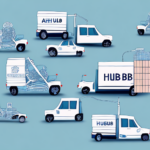An Overview of Piedmont's Distribution Centers and Their Features for 3PL Logistics Fulfillment
Piedmont has been providing third-party logistics (3PL) services for over 40 years, leveraging a network of strategically placed distribution centers to ensure efficient and timely delivery of goods for their clients. In this article, we explore the features and advantages of Piedmont's distribution centers and how they contribute to effective logistics management.
The Importance of Distribution Centers in 3PL Logistics Fulfillment
Without distribution centers, 3PL logistics fulfillment would be a chaotic and inefficient process. These facilities act as hubs for receiving, storing, and distributing inventory, allowing for quick and accurate order fulfillment. Distribution centers are the backbone of any supply chain operation, and Piedmont prides itself on offering state-of-the-art facilities that cater to the unique needs of their clients.
Moreover, distribution centers play a crucial role in managing inventory levels and reducing transportation costs. By strategically locating distribution centers, companies can minimize the distance between the warehouse and the end customer, resulting in faster delivery times and lower transportation costs. Additionally, distribution centers can help companies optimize their inventory levels by providing real-time visibility into stock levels and demand patterns. This allows companies to make informed decisions about when and where to replenish inventory, reducing the risk of stockouts and overstocking.
The Role of Piedmont's Distribution Centers in the Supply Chain
Piedmont's distribution centers serve as critical intermediaries between manufacturers and retailers. They manage incoming and outgoing shipments, perform quality inspections, and handle order processing and fulfillment. Over the years, Piedmont has developed an extensive network of distribution centers strategically located across the country to ensure optimal coverage and minimal transit times.
One of the key advantages of Piedmont's distribution centers is their ability to provide customized solutions to meet the unique needs of each customer. This includes offering value-added services such as kitting, labeling, and packaging, as well as providing real-time inventory tracking and reporting. By tailoring their services to the specific requirements of each customer, Piedmont delivers a superior level of service and support.
In addition to their operational capabilities, Piedmont's distribution centers are committed to sustainability and environmental responsibility. They have implemented initiatives to reduce their carbon footprint, including the use of energy-efficient lighting and equipment, optimization of transportation routes, and adoption of eco-friendly packaging materials. By prioritizing sustainability, Piedmont not only reduces its impact on the environment but also helps customers achieve their own sustainability goals.
A Brief History of Piedmont's Distribution Center Network
Piedmont's distribution center network has evolved significantly since the company's inception in North Carolina in the 1980s. Today, Piedmont operates in all 48 contiguous US states, maintaining a total of 167 distribution centers nationwide. This expansion underscores the company's long-standing commitment to service excellence and innovation, solidifying its position as a leading player in the logistics industry.
A key factor contributing to Piedmont's success is its focus on sustainability. The company has implemented numerous initiatives to reduce its carbon footprint, including the use of alternative fuels and the optimization of transportation routes. Additionally, Piedmont has heavily invested in technology to enhance operational efficiency, such as automated sorting systems and real-time shipment tracking.
Looking ahead, Piedmont is committed to continued expansion and growth. The company is exploring opportunities to extend its international presence, particularly in emerging markets in Asia and South America. Simultaneously, Piedmont is investing in new technologies and innovations to stay ahead in the rapidly evolving logistics industry.
The Geographical Locations of Piedmont's Distribution Centers and Their Advantages
Piedmont's distribution centers are strategically located across the country to ensure optimal coverage and minimal transit times. Proximity to major transportation arteries and population centers allows for speedy and efficient distribution of goods. Moreover, Piedmont's extensive network provides clients with multiple options for shipping routes and delivery methods.
Key advantages of Piedmont's distribution centers include:
- Versatility: Capable of handling a wide range of products, from perishable goods to oversized items.
- Advanced Technology: Equipped with state-of-the-art technology and security measures for tracking and monitoring shipments.
- Strategic Locations: Positioned near major highways, ports, and urban centers to facilitate quick distribution.
This versatility allows clients to consolidate their shipping needs and streamline their supply chain operations effectively.
The Size and Capacity of Piedmont's Distribution Centers
Piedmont's distribution centers vary in size, ranging from small facilities with a few thousand square feet to large, warehouse-style buildings exceeding one million square feet. All facilities are equipped with the latest material handling technology, including automated storage and retrieval systems, conveyor systems, and robotic equipment. This technology ensures efficient and speedy processing of inventory, reducing cycle times and guaranteeing rapid delivery of goods to customers.
In addition to advanced material handling, Piedmont's distribution centers prioritize sustainability. Facilities feature energy-efficient lighting and HVAC systems, utilize solar panels and other renewable energy sources, and implement comprehensive recycling programs to minimize environmental impact.
Strategically located throughout the country, Piedmont's distribution centers optimize transportation routes and reduce shipping costs, allowing for faster delivery times and more cost-effective shipping options for customers. This focus on both efficiency and sustainability ensures that Piedmont's distribution centers can meet the needs of businesses of all sizes and industries.
The Technology Used in Piedmont's Distribution Centers for Effective Logistics Management
Piedmont employs a range of cutting-edge technologies to manage its distribution centers and ensure efficient logistics management. Key technologies include:
- Warehouse Management Systems (WMS): Enable real-time tracking of inventory levels, order processing, and distribution, providing clients with valuable insights into their supply chain operations.
- Data Analytics and Artificial Intelligence (AI): Monitor and optimize warehouse processes, facilitating more effective planning and inventory management.
- Automated Material Handling Systems: Include conveyor belts, automated storage and retrieval systems (AS/RS), and robotic picking systems to reduce manual labor and increase efficiency.
Additionally, Piedmont has implemented various sustainability initiatives within its distribution centers, such as energy-efficient lighting and HVAC systems, solar panel installations, and the use of eco-friendly packaging materials. These technologies not only enhance operational efficiency but also support Piedmont's commitment to environmental responsibility.
The Security Measures in Place at Piedmont's Distribution Centers to Protect Inventory
Piedmont's distribution centers incorporate comprehensive security measures to protect inventory from damage and theft. These measures include:
- 24/7 monitoring of all facilities with video surveillance and access control systems.
- Strict protocols for handling hazardous materials and ensuring compliance with safety regulations.
- Regular security audits to identify and address potential vulnerabilities promptly.
- A dedicated security team that collaborates with local law enforcement to ensure the safety of employees and inventory.
- Ongoing employee training on security best practices and encouraging the reporting of suspicious activities.
These comprehensive security measures demonstrate Piedmont's commitment to safeguarding inventory and maintaining a safe working environment for all employees.
The Different Types of Storage Solutions Available at Piedmont's Distribution Centers
Piedmont's distribution centers offer a variety of storage solutions tailored to clients' unique inventory needs, including:
- Bulk Storage: For large quantities of goods.
- Pallet Racking: Efficiently stores palletized products.
- Drive-In Racking: Maximizes storage capacity for high-density storage.
- Mezzanine Storage: Utilizes vertical space to increase storage capacity.
- Temperature-Controlled Storage: Includes refrigerated and frozen storage for perishable goods.
- Specialized Storage: Equipped for hazardous materials with safety features like fire suppression systems and ventilation.
Additionally, Piedmont's distribution centers implement advanced inventory management systems that utilize barcode scanning and real-time tracking to provide clients with accurate and up-to-date information on their inventory levels.
The Fulfillment Services Offered by Piedmont's Distribution Centers for Small and Large Businesses Alike
Piedmont's distribution centers provide a comprehensive range of fulfillment services to accommodate businesses of all sizes, including:
- Pick-and-Pack Services: Efficiently selecting and packaging orders for shipment.
- Kitting and Assembly: Combining multiple products into a single kit or assembling components as needed.
- Cross-Docking: Directly transferring products from inbound to outbound transportation, reducing storage time.
- Custom Packaging: Tailoring packaging solutions to meet specific client requirements.
- Inventory Management: Maintaining optimal inventory levels and providing real-time tracking.
- Order Tracking: Allowing businesses to monitor the status of their orders in real-time.
Piedmont's fulfillment services are highly customizable, enabling clients to select services that best fit their unique needs. Advanced technology and experienced staff ensure that all orders are processed accurately and efficiently, minimizing the risk of errors and delays.
How Piedmont's Distribution Centers Ensure Efficient Delivery Times for Customers
Piedmont's distribution centers are meticulously designed to ensure the swift and efficient delivery of goods to customers. Key strategies include:
- Continuous optimization of the transportation network to maximize efficiency and minimize transit times.
- Offering a variety of expedited shipping options, including same-day and next-day delivery for urgent orders.
- Strategic placement of distribution centers near major transportation hubs to facilitate rapid distribution.
- Implementing advanced logistics technologies to streamline order processing and dispatch.
These strategies collectively ensure that Piedmont can meet tight delivery schedules and exceed customer expectations for timely deliveries.
The Environmental Sustainability Practices Implemented at Piedmont's Distribution Centers
Committed to minimizing its environmental impact, Piedmont has implemented a range of sustainable practices across its distribution centers, including:
- Energy-Efficient Systems: Utilizing energy-efficient lighting and HVAC systems to reduce energy consumption.
- Renewable Energy: Installing solar panels and other renewable energy sources to power operations.
- Recycling and Waste Management: Implementing comprehensive recycling programs to minimize waste.
- Eco-Friendly Packaging: Encouraging the use of sustainable packaging materials to reduce environmental footprint.
- Optimized Transportation: Planning efficient transportation routes to decrease fuel usage and emissions.
These sustainability practices not only reduce Piedmont's environmental impact but also support clients in achieving their own sustainability goals.
Case Studies: Successful Partnerships with Clients Utilizing Piedmont's Distribution Centers
Piedmont has forged successful partnerships with a diverse range of clients across various industries, including consumer goods, healthcare, and industrial manufacturing. These partnerships have resulted in:
- Improved Order Accuracy: Enhanced precision in order fulfillment, reducing errors and increasing customer satisfaction.
- Optimized Inventory Management: Better inventory control and visibility, leading to reduced stockouts and overstocking.
- Increased Supply Chain Efficiency: Streamlined operations that enhance overall supply chain performance.
These case studies demonstrate Piedmont's ability to develop customized logistics solutions that deliver tangible results for clients, reinforcing its reputation as a trusted 3PL provider.
Future Expansion Plans for Piedmont's Distribution Center Network
Piedmont is actively evaluating opportunities to expand its distribution center network to better serve its growing client base. Future plans include:
- Expanding into international markets, with a focus on emerging regions in Asia and South America.
- Investing in new technologies and infrastructure to enhance logistics capabilities and operational efficiency.
- Continuing to prioritize sustainability by adopting innovative practices and technologies.
- Enhancing customer service through improved logistics solutions and expanded service offerings.
As the logistics industry evolves, Piedmont remains committed to maintaining its leadership position by embracing growth, innovation, and excellence in service delivery.






















